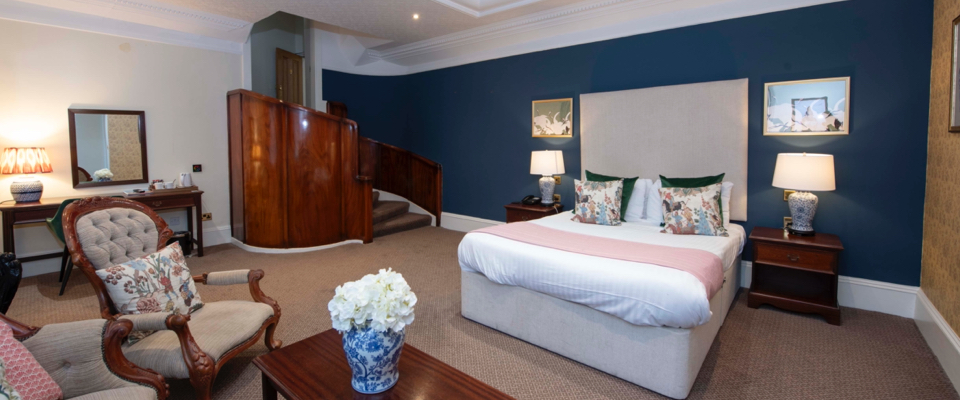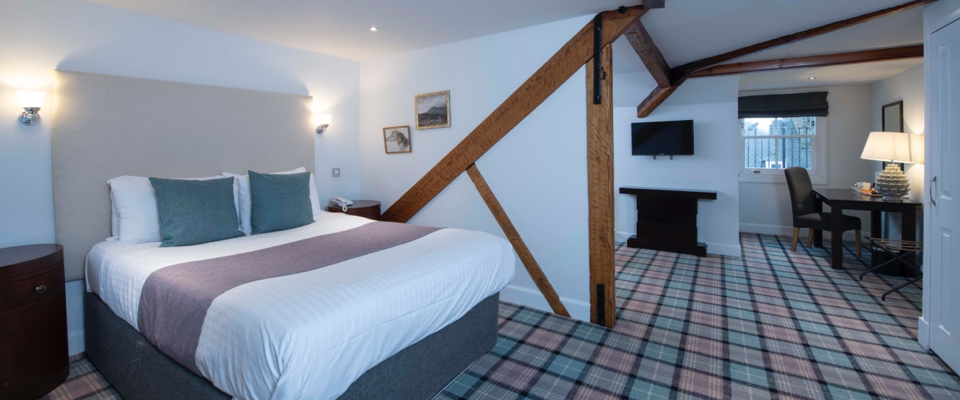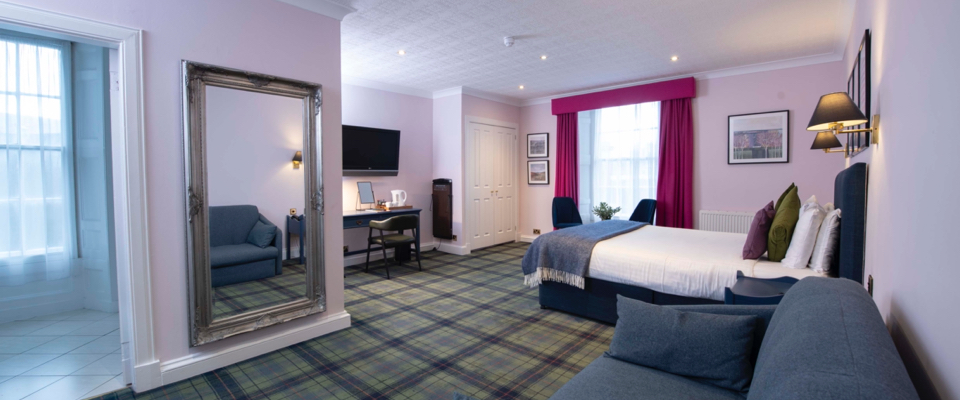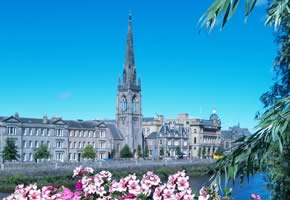History
Quite a corner in The Fair City - a history of Royal George
In the 18th century a new bridge was built across the river near the North Inch and to serve it a major new road was cut through this section of the city. Many old buildings were torn down to accommodate it, and new ones erected in their place. The George Inn, as it was known then, was one of them. It occupies an ancient site in one of the most historically rich areas of Perth.
When Queen Victoria stayed here in 1848, she could look from her window on a little corner of Perth which played a greater part than any other in the history of the city. Across the road once stood a castle, and after its destruction by flood in 1209, a Dominican friary of the Blackfriars was built in its place. It was there that Queen Victoria’s ancestors stayed when they visited Perth, and where the notorious murder of James I took place.
No other place in Perth can claim such historical importance as the corner of George Street now occupied by the Royal George. The monarch of a previous century may have had little time that night to piece together the history which surrounded her, but visitors today can quickly absorb details of the past, thanks to the diligent efforts of local historians and writers. Perth, known for centuries as “The Fair City has much to offer. Her citizens have been working hard to keep it that way, both to preserve remains of her past and secure her place in the future. Whole books can be written and of course one has, purely about the history of the Inches of Perth. Queen Victoria praised them aloud during her first visit to Perth in 1842.
That occasion was marked by huge celebrations and months of flurried activity. The last time a British Monarch visited Scotland was a decade earlier when George IV went to Edinburgh. The people of Perth prepared earnestly for Queen Victoria's arrival. Houses throughout the city were decorated, floral arches were created and a magnificent archway was erected in Atholl Street. The George Inn joined into the spirit with extravagant decorations inside and out. At that time, it was still known simply as The George. It was not until Queen Victoria made her celebrated surprise visit to the Inn in 1848 that it acquired, by appointment, the Royal prefix. The hand carved oak Royal Warrant which was fully restored in 2003 is pictured below and still hangs in the hotel lounge today.
Fit For a Queen
The Queen, Prince Albert, their children and entourage had been holidaying for three weeks at the royal estate of Balmoral in the North of Scotland. They had planned to start their journey to London by sea, leaving from Aberdeen. But as the scheduled time of embarkation the seas were so rough that the royal party was prevented from leaving by sea. Commitments further South demanded their return as scheduled, which left then with the only option of returning overland first by carriage then by train to Perth. From there they would catch the Scottish Central Line south.
A wondrous account if the evening appeared as an inside story in the local paper, giving as much insight into the tame nature of the 19th century journalism as the events which were reported. Headlined simply “Departure of Her Majesty from Balmoral”, it is not until the eight long paragraph that we learn that Her Majesty arrived to stay a night in Perth at a moment’s notice. The Royal party arrived at Perth station about 7 in the evening. The city officials were given less than two hours’ notice to turn the yet unfinished building into a station fit to welcome a queen. Fortunately, there was just time to roll out the red carpet and spruce up the interior before the train arrived. Upon disembarkation, the Queen and family, including Prince Albert, retired to the ladies waiting room to finalise the plans for their overnight stay. On her previous visit of 1842 she had spent the night at nearby Scone Palace, and it was to that mansion, home of the Earl of Mansfield, that word was first sent. The Earl, however, was out of town and therefore lost an opportunity to offer her Majesty bed and breakfast. It was a great compliment to The George that it featured second on the list after Scone as suitable shelter for a travel weary Monarch. Word was sent to the Inn that her Majesty would like to stay and, not surprisingly, room was found. Mr A Fowler, from England, willingly vacated his rooms, which were smartly re-laid for the advancing entourage. Carriages met the Queen at the station and took her swiftly through the streets to The George, where already a small crowd had gathered - though not, it was reported, exceeding the size which usually gathered for the judges when they arrived at The George on their circuit.
As fate would have it, the host of the George, Mr Davidson, had left that morning with a friend to view the Queen’s planned departure from Aberdeen. One can well imagine the state into which the gentleman must have flown when he learned that not only had the Royal plans changed, but the royalty in question was at that very moment being ushered through his very own doorway.
Having taken everyone by surprise, the Queen resisted any attempts to provide her with a regal reception. She arrived at The George modestly dressed, wearing a plain grey ground, tartan shawl and simple bonnet. Her husband and daughter were simply dressed as well, but the young Prince of Wales reportedly looked resplendent in full Highland regalia.
Observers remarked on how well and happy the family appeared, 'much improved in looks for three weeks’ residence in the highland air'. Upon the Queen’s arrival, a Royal guard was posted around the hotel and the Royal party entered to refresh themselves briefly before sitting down to dinner. It is said that The George’s housekeeper didn’t feel that the hotel silver was elegant enough for Her Majesty and so borrowed a better set from a local lawyer. The queen insisted that the hotel’s normal routine should continue as usual - no doubt a difficult request to honour despite the good intentions. The royal attendants directed service in their accustomed manner and following coffee the monarch retired to bed at about 11pm.
As was her habit, the Queen rose early and breakfasted privately with her family. After breakfast she granted a local audience to the local print seller, Mr Jackson, who showed her engravings depicting her visit from 1842 and from this group she selected a few to take with her. She then held a private audience with Mr Davidson, who had hastily returned from Aberdeen that morning and assured him that all of the arrangements had been perfectly satisfactory. Such a compliment is remarkable for two reasons. Firstly, the hotel must have been well run in order to begin with if it could accommodate Royalty on half an hour’s notice. And, even more remarkably, the experience was an important one for the Queen who had never before stayed in a hotel. Her visit to The George created a sufficiently good impression about hotels that she took the earliest possible opportunity to repeat it; the occasion in fact, arose the next evening when she again broke her journey en route to London. As for The George, it too enjoyed the experience according to the local newspaper, which wrote 'We understand the Royal visitors gave much less trouble in the establishment than the generality of public parties'.
Bedposts and ... Standard Lamps?
The Queen and her party left The George shortly after 9am and travelled to the station which had been transformed overnight. They left a startled but delighted city, which was to welcome them frequently in the future as they travelled regularly to Balmoral. It was soon after the visit that the hotel changed its name, by Royal appointment, from The George to The Royal George. Memories of that night were not about to fade. For many years the room in which the Queen stayed was almost sacred, and the bedposts from the bed in which she slept were preserved forever for public view. They were removed from the bed itself and made into two pedestal lamps which are still use in the main lounge. One curious detail about these otherwise attractive lamps is the disparity between the dates given on the brass plates affixed to each. One says that the Queen visited on 29.9.1848 and the other says it was 29.8.1848. Why the engraver made this error, or why the management allowed it to remain is unknown. But in fact it was 29th September that the Queen made her historic visit.
It is somewhat incongruous that so much pleasure was taken by the citizens of Perth when Queen Victoria visited. For this is a city which has played a crucial part in the history of a country frequently opposed to and often battling with England.
The Hub of the Universe
In 1766, the great engineer Smeaton of York was commissioned to survey and design a new bridge for the city. Work was completed five years later and, to serve the new bridge, George Street was opened in 1773. Taking its name from the street and the kings it honoured, The George Hotel opened shortly after.
The original building was only a fraction of the size The Royal George is today. Its pretty, nicely proportioned front opened onto George Street - now the entrance to the Morning Room. George Street and the Perth Bridge now provided a first class 'gateway to the Highlands' from Perth. The time was right for a first class hotel. In its early days, of course, The George would be known simply as an inn. But times change quickly. One noted local historian, Peter Baxter, wrote in 1929 that, 'Everything changes, but let every change be for the better is a fine old maxim. This holds well especially in regard to inns and hotels. Our grandfathers were pleased to call a place of refreshment and rest an inn. Now, we adopt the French word hotel…'. He went on to describe The George as, 'in conception, erection and accessories was, and has ever been, one of the best hotels in Scotland.'
The Royal George, therefore, developed with the city and with the times. When Perth’s first official Post Office opened up across the street, the George became busier than ever. Local people called the corner by The George 'The hub of the universe'. Crowds would congregate to greet the mail coach and to read precious, fresh newspapers. While they did so the horses from these coaches would be refreshed and changed at The George, which was rapidly to become a prime coaching inn for the city. Business became brisk when a coach booking office opened opposite The George and the Coaches known as the 'Diligence' and 'Caledonian' both stopped at the hotel.
Passengers would be travelling between Aberdeen and London, or Glasgow and Dundee, neither of which was a particularly easy route in those days. The George became a natural place to break an otherwise long and uncomfortable journey. Passengers would leave somewhat refreshed, often with a little something to take on their way. It was estimated that a quart of Perth porter and a bag full of biscuits would last the average passenger 20 miles.
Not everyone, of course, moved on so quickly. The George was also the place for the Highland Lairds, cattle dealers, Jacobite Nobles and Perthshire country gentlemen. They would make the George their headquarters for a few days of business and, one would assume, not a little pleasure. Everyone benefited from the custom. While the gentlemen dined upstairs his piper manservant would entertain the female servants, ostlers and post boys below stairs. One tragedy from the era occurred in 1816 when fire broke out one evening in the stables. Incredibly, the ostler slept soundly nearby and noticed nothing. Not so lucky were the twelve horses which perished in the blaze.
Twenty years later the coaching business in Perth was at its height. Seventeen coaches would arrive and depart daily, including the 'Defiance' and the 'Fair Maid'. At its best The George could provide stabling for 20 horses and all the necessary staff and service.
Travel by coach quickly became unfashionable and impractical when the railway opened in Scotland. Perth railway station was still unfinished in 1848 when its most prominent visitor, Queen Victoria, dropped by unexpectedly, but the station was soon one of the most important in the country, lying as it did on one of the major transportation routes.
Onwards and Upwards
After the coaching trade finished, life at The Royal George settled down almost too quietly. When its most ambitious landlord, William Steele, took over at the beginning of the 1900’s it was a quiet inn of little note. Steele had eyes bigger than his bank balance and few believed that he could manage the vast extensions and renovations he planned. Steele took over the hotel in 1910 and initially started with only four furnished bedrooms. Little by little work began on the hotel, interrupted by Steele's war duties, which took him abroad as an ambulance driver. When he returned the extension began in earnest.
In 1924 a new wing was built with 21 new rooms, followed by, four years later, the construction of the front hall along with the oak staircase. To celebrate the re-opening of The Royal George after these extensive renovations, a huge reception was held, which Lord Provost Dempster, magistrates, members of the city council and citizens attended. People queued along George Street just to get in and have a look, and later a civic recognition was given to The Royal George and Steele for the work done to improve this fine old building. Improvements continued over the years with the addition of a 'Chinese Lounge', inspired by a trip Steele made to the East. The Royal George was now a very different looking hotel. The entrance had changed to open onto the Tay, covering what used to be the Lady Walk, where not only ladies but horses on their way to the races at the North Inch would parade. In 1936 the hotel was sold to a Mr Lomas and noted visitors continued to come, including troops who were training nearby for WWII and such illustrious names as Queen Salote of Tonga, Anna Neagle and Herbert Wilcox. In 1964 the hotel was sold to Trusthouse Forte Limited, then to Regal Hotels Plc and finally in 2000 it returned to private ownership under Mr Edward Anderson, who has owned and continued to upgrade it ever since.
The hotel is still the centre of many activities in Perth, although some of the earlier flavour has gone. No longer do candidates address crowds from the little balcony on George Street, or do the crowds come with the sort of attention they had in 1932, when they burnt there the effigy of Henry Dundas, Viscount Melville, during the unrest which accompanied the reform bill. Large gatherings today are more likely to be for weddings, receptions or conferences.
Those who are not taking advantage of the excellent business facilities at The Royal George are likely to be visiting Perth for its tourist attractions or to break their journey on the way to the Highlands. The historical connections in this part of the town make the Royal George an ideal centre. There is no longer a castle or a friary across the street, but instead an art gallery and museum designed by an amateur architect, David Morrison in 1824.














